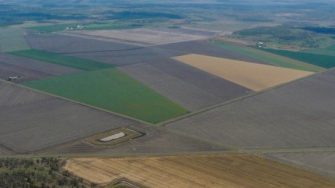
Date: Tuesday, October 10, 2017
Project: Eastern Australian Waterbird Survey
After overnighting in the Mulga Country town of Charleville we continued our journey east towards Kingaroy where beautiful red volcanic soils dominate. Along this transect extensive areas of mulga and gidgee scrub sustain goats, kangaroos and cattle. The odd dingo was seen as were newly constructed dog fences erected to protect clusters of sheep properties from dingo predation.
The droughty conditions have affected crops so badly many are now being used to feed stock as they are not worth harvesting.
The Darling Downs is some of the best farming country in Australia (Photo: Terry Korn)
The large dam north of Kingaroy, Lake Barambah, is the lowest it has been for more than a decade. The section inside band seven has shrunk to such an extent that water now only remains in the original water courses. Locals not on mains water have been desperate for rain to fill their tanks. All this adds to few birds but this all changed after we crossed the magnificent Darling Downs when moving south 200km to Band six and Coolmunda Dam. As a Specified Environmental Asset (SEA) with the Murray Darling Basin we had to count it twice and this took thirteen minutes at 110knots or about 210km per Hour. It was loaded with hardhead ducks, coot, Little black cormorant, pelican, grey teal and Black Swan. Many people fish the lake and are always ready to wave as we skim over their boats.
Winter crops have suffered but on-farm storages are full for summer crops (Photo: Terry Korn)
West of this point are the extensive off-river storages along the Macintyre/Barwon River systems between Goondiwindi and St George. Most water storages are full or near full in preparation for summer crops such as cotton. The winter crops of wheat which are harvested about now generally looked poor so yields will be low.
There is a small flow in the Barwon River (Photo: Terry Korn)
